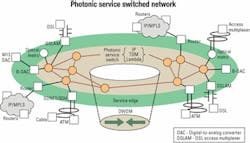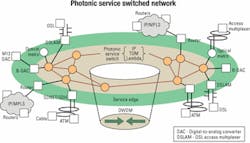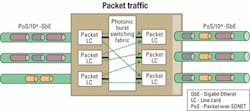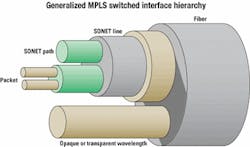GMPLS, photonic service switching, and network's future
The question of layer integration for network operators is not 'whether' or 'how,' but 'to what extent' and 'when.'
DEBASHIS BASAK, AcceLight Networks
Telecommunications service providers are under great pressure to improve the efficiency and flexibility of their networks. Demand for bandwidth and service is not diminishing, but customers are increasingly careful with the bottom line. Several innovations are at the forefront of industry for evolving networks to effectively respond to these pressures. Changes that are currently in development or already implemented include simplification of network architectures for improved provisioning and better use of resources; deployment of new switching technologies for more scalable and flexible networks; and adoption of protocols to extend IP control-plane capabilities to other traffic types for more intelligent and flexible networks. The focus here is on Generalized MPLS (GMPLS) as well as a new fast opaque optical-switching technology called photonic service switching (PSS) and how it affects network design and efficiency.
The layer problemNetworks today are predominantly layered. The layered architecture grew out of pressures for new services and increased capacity. They represent a "divide and conquer" approach. Each layer added to the network is designed to handle a specific type of traffic and deliver specific services. With time, these layers have come to be represented, roughly, by devices specialized in one layer and one type of traffic: IP routers for packet layer services; ATM switches for fine-tuned traffic engineering capabilities; SONET/SDH devices for rapidly restorable point-to-point transport; and DWDM switches for efficient transmission.This multitude of specialized devices, each offering a limited set of networking capabilities, makes design of the devices simpler but results in complex, layered networks. In addition, the fact that management and control of each layer evolved in different contexts led to implementation of very different control philosophies in each layer, making network management a very complex and expensive enterprise.
Responding to this problem, the telecom industry has periodically attempted to limit the cost of building and managing networks by consolidating layers and reducing the diversity of deployed devices. Layers cannot just be wished away, however. The benefits they offer must incorporate as functionality in the remaining layers.
A recent example of an attempt to reduce the network layers was the effort to move from IP-over-ATM networks to IP-over-MPLS networks. This change was supposed to eliminate the need to manage a separate ATM technology, thus permitting eventual replacement of ATM switches by IP label-switched routers (LSRs). While this simplification may have been a worthy aim, it required significant enhancement of the IP protocols in MPLS to incorporate the key advantages of ATM, such as the ability to establish connections and implement traffic engineering using connections.
Similarly, the recent development of optical transport opened the debate on whether to eliminate the SONET/SDH layer in favor of architectures designed with IP LSRs directly connected to optical crossconnects (OXCs). The requirements for the benefits (such as grooming and protection/ re storation) offered by SONET/SDH remain, however. The most efficient network is not worth much if it does not generate revenue. SONET/SDH services are a huge market for many operators who cannot be reasonably expected to forego the revenues these services produce in exchange for the promise of a more efficient network.To maintain these markets and revenues while running an IP-over-DWDM network, then, protection and restoration are necessary in the IP or optical layers or both. Offering SONET services with an MPLS infrastructure implies complex emulation capabilities built on MPLS and LSRs. The new protocols required would take years to develop, mature, and attain the credibility that SONET has today.
Clearly, the solution to the layer problem is not simply a matter of doing away with layers. Rather, the solution is to reduce the number of distinct devices on the network and simplify the management infrastructure across the layers. Preferably, this solution does not require invention of new protocols. But it does require a device that can support interfaces for different layers and offer vertical integration without elimination of layers.
Overlay to peer
For historical reasons, control and management of the different network layers are based on disparate philosophies. The evolution of networks by layers naturally led to the "overlay network." An overlay network divides into IP (or "service") and SONET/optical (or "transport"). There is typically no exchange of topology and resource information across the service transport boundary. This overlay architecture makes the layered physical network expensive to manage and makes inefficient use of bandwidth.
The peer model is supposed to enable seamless interconnection between IP and optical networks. But though it allows visibility between network layers, a peer network, in fact, maintains the traditional layered physical architecture with its disparate network devices, thus retaining many of the complexities and inefficiencies inherent to overlay architecture.
A vertically integrated or "homogeneous" network is an alternative to both overlay and peer networks. It does away with the layered physical architecture, proposing a network built with vertically integrated network elements. Figure 1 shows an example of a vertically integrated network deploying a PSS switch. Note that only one type of network element (NE) is required for the integrated services and transport network.
The full benefit of a vertically integrated architecture can be achieved if control and management is integrated across the different layers supported by the single device. In this sense, a vertically integrated network is similar to a peer network. All NEs can use GMPLS as the common routing and signaling protocols, having full knowledge of all other NEs and network topology. A vertically integrated network is more efficient than a peer network, however, because it allows reductions in the diversity of required elements and greatly simplifies physical architecture.
A vertically integrated network architecture requires a new NE such as the PSS switch-a fast opaque optical switch capable of switching IP, TDM, and wavelength traffic simultaneously. Being a vertically integrated device, it does away with the need for layer-specific devices. The Table compares important attributes of layered and vertically integrated network architectures.A vertically integrated network, therefore, supports different types of interfaces, including IP, TDM, and wavelength in the same device. It reduces the number of devices deployed and gives operators more choice in designing networks. Vertical integration maintains the capabilities and benefits of the different network layers that operators know and need, such as IP or MPLS, SONET, and optical. Operators can take full advantage of the unique capabilities-granularity, protection and restoration functions, etc.-of each layer, while gaining in network simplicity and efficiency.
A common management infrastructure, enabled by the philosophy of GMPLS, makes management and provisioning "homogeneous" across all network layers-and a service can be allocated to the most appropriate networking layer. Finally, vertical integration does not require emulation of one layer in another.
PSS and GMPLS
PSS network architecture requires, and is possible because of, GMPLS and a new type of NE: the PSS switch. With solid-state, fast optical fabric and electrical line cards, this switch combines the best attributes of optical and electrical technologies. Figure 2 shows a PSS switch configured for multiple traffic types, and Figure 3 shows the PSS switch configured with packet interfaces only.
The optical fabric of the PSS switch ensures almost limitless scalability. Line cards are specific to traffic type, so the switch is adaptable for different environments simply by a change of line cards. For example, it can be deployed in a pure IP environment, then changed to also switch TDM traffic by adding the appropriate line cards. This versatility means that a PSS switch is perfectly suited for an eventual migration from overlay toward GMPLS-enabled PSS network architectures.
GMPLS enables automated provisioning of all traffic types. A logical advance from IP through MPLS and MPlS, it is a suite of protocol extensions providing common control to packet, TDM, and wavelength services. These extensions affect routing and signaling protocols for activities such as label distribution, traffic engineering, and protection and restoration. Development of GMPLS began with the following premises:
- The routing and signaling protocols developed and used in IP networks can extend and adapt to meet the needs of other traffic types, namely TDM and wavelength.
- This extension would allow full integration of provisioning for all traffic types.
- Improvements in optical-switching technology would eventually allow wavelength conversion and, given suitable protocols, make intelligent optical switching possible.
GMPLS has a full suite of capabilities that can be used as the "glue" to bind the various parts of a network designed to carry multiple traffic types. Figure 4 shows the GMPLS switched interface hierarchy.
Faster and more accurate provisioning, along with more efficient protection and restoration schemes are just two benefits GMPLS can bring to future networks. GMPLS uses the control plane to automate resource and network topology discovery and streamline and accelerate the process of establishing and tearing down connections. This automation makes a GMPLS network agile and readily able to respond to customer requests and network engineering dynamics. By replacing notoriously unwieldy centralized, manual processes still dominant in point-to-point circuit provisioning with automated distributed processes, GMPLS not only increases provisioning speed, but also reduces error.Similar far-reaching advances for protection and restoration are also possible. Though each layer of an overlay network is efficient for the specific type of traffic it carries, it is often necessary to duplicate protection between layers. A service network with its own protection mechanism may also rely on services links-in fact, connections through the transport network. In a layered network, the service network has no information about the transport network and cannot know if the links through the transport network are diverse. It must specifically request the desired level of protection across the transport network, often duplicating resource allocation.
In a peer or vertically integrated network enabled by GMPLS, the communications barrier between services and transport is eliminated, and the required protection is established with minimum resources. If the service network is assured of path diversity through the transport portion of the path, it can choose not to use protection over transport. Combined with whatever redundancy is required at the service level, the diverse transport paths are sufficient protection. Further duplication is not required. Resources can be allocated to other uses and the savings passed onto customers.
Similarly, protection on the transport side of the network gains efficiencies from the sharing of information provided by GMPLS. For ex-ample, if the transport side knows that two service links are not interdependent in the service layer protection scheme, it can ensure they share backup resources at the transport layer. There is no need to allocate separate resources twice.
Not all or nothing
Peer and vertically integrated network architectures enabled with GMPLS do not require implementation all at once. It is not a question of all or nothing, but of where first and in what order. To start, GMPLS and PSS can be deployed in just one layer of a traditional overlay network, with deployment extended in phases to other layers as required to improve overall network efficiency. The following describes possible phases for implementing GMPLS for eventual migration to a vertically integrated network with PSS or PSS-like NEs:
- For Phase 0, today's common overlay network is assumed. The IP service network is running IP/MPLS protocols. The transport network (SONET/ optical) uses network management or proprietary protocols to facilitate service setup-point-to-point connections between NEs. Provisioning personnel make requests to set up or tear down connections by telephone or through a Web interface.
- Phase 1 is designed to increase the speed and accuracy of connection requests, thus increasing network flexibility and efficiency. It automates requests from the service network to the transport network for connection setup and teardown. The service network communicates requests to the transport network through a signaled interface. A prime candidate for this interface is the Optical Internetworking Forum's UNI, which is based predominantly on GMPLS signaling protocols.
- Phase 2 standardizes protocols across layers, moving the network closer to fully integrated control for the service and transport layers. With Phase 2, GMPLS protocols replace network management and proprietary control protocols in the transport network to facilitate establishment of connections between nodes for service setup.
- Phase 3 is the final phase of integration. Once operators can take full advantage of the efficiencies realized by vertically integrated network architectures, the exchange of information between their service and transport networks-integration of the control plane-follows. GMPLS is the standard for signaling and routing protocols for all traffic types across a network of GMPLS-capable PSS switches. All NEs have full knowledge of all other NEs carrying all types of traffic. GMPLS routing and signaling are used for wavelength and TDM as well as packet traffic. Efficiencies are further increased by configuration of switches with the exact mix of packet, TDM, and wavelength line cards required for traffic loads.
New possibilities
It is obvious that GMPLS and PSS can be used in layered or vertically integrated networks. GMPLS extends one suite of routing and signaling protocols to packet, TDM, and wavelength traffic. It brings IP intelligence, including quality of service, to all traffic types to streamline provisioning and improve protection and restoration schemes. GMPLS can improve the efficiency of overlay and transitional networks but ultimately offers the greatest efficiencies in PSS networks.
Full-layer integration is not the best solution in all cases. For instance, network operators may not want to share all network information with their competitors. However, increased demand for services and bandwidth, along with the steadily increasing complexity of networks as they evolve from ring to meshed topologies, make simplification of architectures imperative wherever possible.
The migration tools for tomorrow's more efficient networks-GMPLS and PSS-are available today. The question of layer integration for network operators therefore is not "whether" or "how," but "to what extent" and "when." The answer is "as much as possible, as soon as possible."
Dr. Debashis Basak is senior network architect at AcceLight Networks (Pittsburgh) and represents the company in the IETF and OIF. He can be reached via his company's Website, www.accelight.com.





